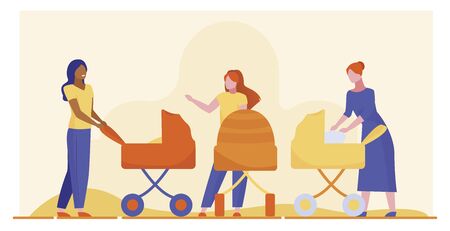Introduction to Baby Poop: Why It Matters
When you become a parent, you quickly realize that diaper duty is more than just a daily chore—it’s actually a window into your baby’s health. While it might not be the most glamorous topic, paying attention to your babys poop can tell you a lot about their well-being. From color to consistency, every diaper change can give you clues about how your little one is doing.
Why Should Parents Pay Attention?
Your babys digestive system is still developing, and changes in their poop often reflect whats going on inside their tiny bodies. Noticing whats normal for your baby can help you spot early signs of illness or food sensitivities before they turn into bigger problems. For example, certain colors or textures may signal allergies, infections, or even dehydration. So, keeping an eye on those diapers isn’t just a parental rite of passage—it’s an important part of making sure your baby stays healthy.
What Can You Learn from Your Baby’s Poop?
Here are some things parents can pick up by observing their babys poop:
| What to Look At | What It Might Mean |
|---|---|
| Color | Helps identify possible diet issues or infections (e.g., green could be normal or mean something changed in their diet) |
| Consistency | Shows hydration and digestive health (loose stool could mean diarrhea; hard stool might suggest constipation) |
| Frequency | Lets you know if your baby is eating enough and digesting well (too few or too many diapers may need attention) |
| Odor | A sudden strong smell could point to illness or changes in what they’re eating |
The Bottom Line for Parents
While it might seem odd at first, getting comfortable with tracking your baby’s poop helps you catch early signs of potential issues—and gives you peace of mind as you care for your growing child. So next time you’re changing a diaper, remember: you’re not just cleaning up; you’re also learning more about your baby’s health every day.
2. What’s Normal: Colors, Textures, and Frequencies Explained
If you’re a new parent, you might be surprised by just how much time you’ll spend thinking about your baby’s poop! While it might not be the most glamorous part of parenthood, understanding what’s normal can help you feel more confident and calm as your baby grows. Here’s a simple guide to what you can expect when it comes to color, texture, and frequency—plus how things might look different for breastfed and formula-fed babies.
Typical Changes in Color
It’s totally normal for your baby’s poop to change color over time. Here’s a quick breakdown:
| Age/Feeding Type | Common Colors |
|---|---|
| First Days (Meconium) | Black, tar-like |
| Breastfed Newborn | Yellow, mustard, sometimes greenish |
| Formula-fed Newborn | Tan, yellow, brown, sometimes greenish |
| Older Infants (Starting Solids) | Browns, greens, even orange or bits of food colors |
What Do These Colors Mean?
– Black or dark green: Normal in the first days (meconium), but later on it can signal something to check with your doctor.
– Yellow or mustard: Very common in breastfed babies; usually nothing to worry about.
– Green: Can happen with both breastfed and formula-fed babies—often harmless.
– Brown/tan/orange: Normal as babies grow and start solids.
Texture: From Sticky to Seedy to Solid
The texture of your baby’s poop will also change as they grow:
| Stage | Description |
|---|---|
| Meconium (first days) | Sticky, thick, almost like tar |
| Breastfed Baby | Loose, runny, seedy (like little mustard seeds) |
| Formula-fed Baby | Pasty or peanut butter-like; thicker than breastfed stools |
| Starting Solids | Softer formed stool; bits of undigested food are common |
A Few Texture Tips:
– Breastfed babies often have looser stools that can look watery or seedy—this is normal!
– Formula-fed babies tend to have firmer poops.
– As solids are introduced, poop gets bulkier and may include pieces of food.
Frequency: How Often Should Your Baby Poop?
This is one of the biggest worries for parents—but there’s a wide range of normal! Here’s what you might see:
| Age/Stage | Normal Frequency Range |
|---|---|
| First Week (Newborn) | Every diaper change or several times a day (especially after feeds) |
| 1-6 Weeks (Breastfed) | 4+ times/day at first; may slow to once every few days as baby gets older |
| 1-6 Weeks (Formula-fed) | 1-4 times/day is typical; tends to be more regular than breastfed babies |
| Around 2 Months & Older | Might go several days without pooping—still okay if baby seems comfortable! |
| After Starting Solids | Bowel movements often become more regular (once a day or every other day) |
A Friendly Reminder:
No two babies are exactly alike. Some go a lot; others much less. If your baby seems happy and is growing well, chances are their poop routine is just right for them!

3. When Poop Changes: Common Reasons Behind Variations
Its totally normal for parents to be surprised or even a little worried when their babys poop suddenly looks different. Babies digestive systems are still developing, so changes in poop color, texture, and frequency happen all the time. Most of these changes are harmless and linked to common milestones or minor upsets. Lets break down some everyday reasons you might notice your babys poop looking or smelling different.
Introducing Solid Foods
Starting solids is a big step for babies—and their tummies! Once you introduce foods like pureed carrots, peas, or rice cereal, expect to see changes in your baby’s stool. The color might shift to orange, green, or even have bits of undigested food in it. You may also notice a stronger smell (yep, thats totally normal!).
Typical Changes When Starting Solids:
| New Food | Possible Poop Changes |
|---|---|
| Carrots/Sweet Potatoes | Orange tint |
| Puréed Peas/Spinach | Greenish color |
| Rice Cereal/Bananas | Thicker texture, sometimes more firm |
| Berries/Beets | Red or dark streaks (don’t panic!) |
Teething and Poop Changes
If your baby is drooling more than usual and wants to chew on everything in sight, teething could be right around the corner. Some parents notice looser stools during this time. This happens because babies swallow extra saliva, which can make their poop runnier than normal. Unless you see signs of dehydration or blood in the diaper, this is usually nothing to worry about.
Minor Illnesses and Poop Patterns
A cold or mild stomach bug can also change your baby’s poop. You might see more frequent diapers, diarrhea, or a bit of mucus mixed in. As long as your baby is still eating, drinking, and seems generally happy, these changes often clear up on their own within a few days.
Quick Reference: Common Causes of Poop Changes in Babies
| Cause | What You Might Notice | When to Call Your Pediatrician? |
|---|---|---|
| New foods (solids) | Color and texture changes, bits of food | If theres persistent vomiting or refusal to eat solids |
| Teething | Slightly looser stools, more drool in diaper area rash possible | If diarrhea lasts more than a week or there’s blood in stool |
| Mild illnesses (cold/stomach bug) | Mucus in stool, increased frequency, occasional diarrhea | If baby seems dehydrated (few wet diapers), has a high fever, or blood appears in stool |
| Drops in appetite or minor stress (like travel) | Slight constipation or firmer stools for a short period | If constipation lasts longer than a few days or causes discomfort |
4. Red Flags: When to Call Your Pediatrician
As a parent, you get used to your babys poop changes pretty quickly. Still, there are certain signs that mean it’s time to check in with your child’s doctor. Here’s a simple guide on what to watch for and when you shouldn’t wait to call your pediatrician.
Key Warning Signs in Your Baby’s Poop
| Sign | What It Might Mean | When to Call the Doctor |
|---|---|---|
| Blood in Stool | Possible allergy, infection, or tiny tear (anal fissure) | If you see bright red or black blood, call right away |
| Persistent Diarrhea | Could lead to dehydration or signal an infection | If diarrhea lasts more than 24 hours or baby seems dehydrated (fewer wet diapers, dry mouth) |
| Severe Constipation | Might be a sign of dietary issue or rare medical condition | If baby hasn’t pooped in several days and seems uncomfortable or is straining hard |
| Unusual Colors | White, gray, or very pale stools could mean liver problem; black stool (not first few days) could mean bleeding in stomach/gut | If poop is white/gray/black (after newborn stage), call right away |
| Mucus in Stool | Sometimes related to teething, but can also mean infection or allergy | If it happens often or is paired with other symptoms like blood or fever |
| Strong Foul Odor + Other Symptoms | Might point to infection, malabsorption, or food intolerance | If paired with vomiting, fever, poor feeding, or weight loss |
Other Symptoms That Need Attention
- Your baby has a fever and unusual poops at the same time.
- Your baby is not eating well, seems very sleepy, weak, or irritable.
- Your baby shows signs of dehydration: no tears when crying, dry lips/mouth, fewer than 6 wet diapers a day (for infants).
- You just feel that something isn’t right—trust your gut!
Remember:
If you’re ever unsure about your baby’s poop or overall health, it’s always okay to call your pediatrician for peace of mind. You know your baby best!
5. Everyday Tips for Monitoring and Managing Diaper Changes
Keeping Track of Diaper Changes Like a Pro
When you’re caring for a new baby, those diaper changes can feel never-ending! But keeping an eye on your baby’s poop is one of the best ways to monitor their health. Here are some easy, real-life tips American parents use every day to keep things clean, comfy, and under control.
Use a Diaper Chart or App
Tracking dirty and wet diapers helps you notice changes early. Many parents find it helpful to jot notes on a simple chart or use an app. Here’s a quick comparison:
| Tracking Method | Pros | Cons |
|---|---|---|
| Paper Chart (on fridge or nursery wall) | Easy for all caregivers to see; no tech needed | Can get lost or messy; not portable |
| Phone App (like Huckleberry or Baby Tracker) | Portable; can set reminders; easy to share with pediatrician | Requires phone access; may need setup time |
Diaper Changing Station Must-Haves
- Wipes: Opt for unscented, hypoallergenic wipes if possible.
- Diaper cream: Prevents and soothes diaper rash—keep it handy!
- Hand sanitizer: Great for when you can’t wash your hands right away.
- A small trash can with a lid: Keeps odors in check and is easy to empty.
- A change of clothes for baby (and sometimes you): Accidents happen!
Stay Ahead of the Mess
Avoid blowouts by checking diapers frequently—every 2–3 hours is typical for newborns. At night, try overnight diapers or double up with a liner if your little one tends to leak.
Culturally Savvy Tips from American Parents
- On-the-go kits: Keep a zip-up pouch with diapers, wipes, and a disposable changing pad in your car or stroller.
- Laundry hacks: For stubborn stains, soak soiled clothes in cold water ASAP and treat with gentle stain remover before washing.
- Pediatrician updates: Bring your tracking notes or app data to well-baby visits—it helps answer common questions about feeding and digestion.
- Scented diaper bags: These small bags help contain odors when you’re out visiting friends or at daycare.
Your Comfort Matters Too!
If you’re changing lots of diapers each day, consider using a washable changing pad cover for easy cleanups and comfort. Don’t forget to take breaks, drink water, and ask your partner or family for help when you need it—caring for your baby is important, but so is caring for yourself.
6. Conclusion: Trusting Your Parental Instincts
As a new parent, you’re probably already spending a lot of time checking diapers and wondering if everything is okay with your baby’s poop. While it’s natural to worry, remember that every baby is unique and there’s a wide range of what’s considered normal. It’s important to stay alert for changes, but just as important is trusting your own instincts—you know your baby better than anyone else.
Finding Balance: When to Watch and When to Relax
It can feel overwhelming trying to spot every sign or symptom, but most of the time, your baby’s poop will fall into the “normal” category—even if it looks a little different from what you expected. Here’s a quick table to help guide you:
| What You Might See | Is This Normal? | When to Call the Pediatrician |
|---|---|---|
| Yellow, seedy poop (breastfed) | Yes | If stool becomes consistently watery or mucusy |
| Greenish or brown poop (formula-fed) | Yes | If there’s blood, or sudden drastic change in color/consistency |
| Occasional constipation or straining | Usually normal | If baby seems in pain, has hard pellets, or goes several days without pooping |
| Mild variations in smell and texture | Yes | If stool smells extremely foul and baby acts sick |
| A little mucus or undigested food (older babies) | Often normal | If persistent or accompanied by diarrhea/fever/vomiting |
Reassurance for New Parents
No two babies are exactly alike—what’s totally normal for one might be unusual for another. Some babies go several times a day, others only every few days. Some have runny diapers; others are more pasty. The key is getting to know your own baby’s patterns over time.
Your Instincts Matter
If something feels off to you—even if it doesn’t fit the “textbook”—it’s always okay to call your pediatrician. You don’t need to have all the answers; being cautious means you care. But also give yourself credit: trust what you see and feel. Most parents develop a sixth sense about their child’s well-being pretty quickly.
You’ve Got This!
Remember, worrying comes with the job description of being a parent—but so does learning to trust yourself. Stay attentive, stay informed, but don’t forget that your love and attention are the most important things for your baby. You’re doing great!


